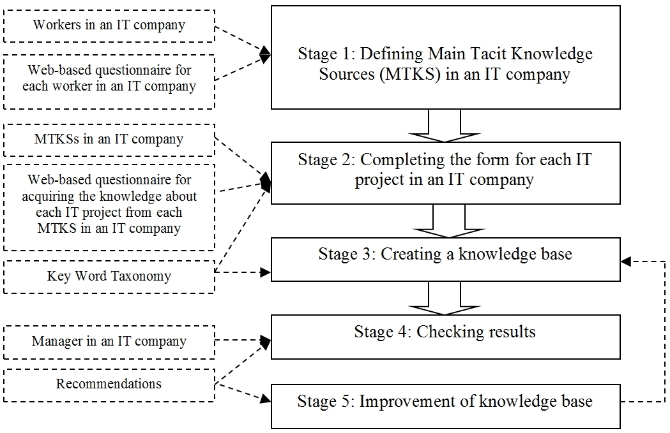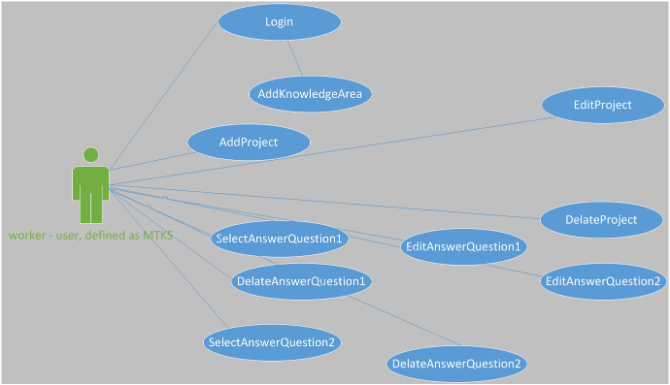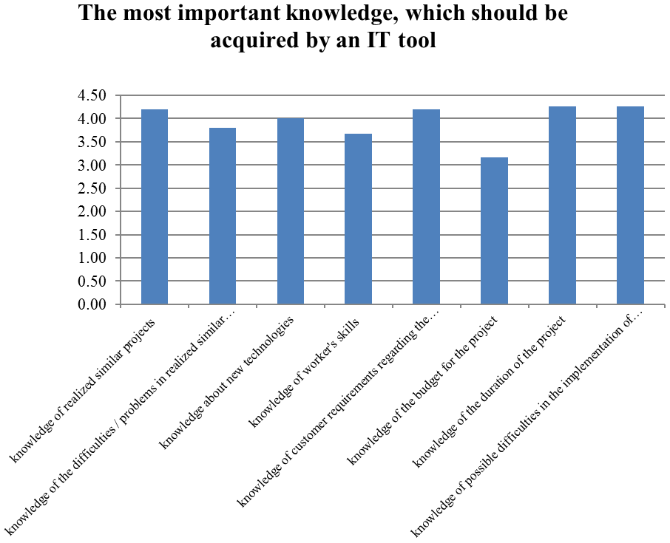1.
Introduction ^
2.
Theoretical background ^
3.
A model of an Application for Tacit Knowledge Acquisition Support for an IT company ^
Stage 1:
INPUT: Web-based questionnaire about typically realised processes: Pn ϵ ≤1;69≥ for each worker in an IT company: W = {W1,…, Wm}, mϵN
begin
select workers, whose realise business processes PR in time in a given month in a defined range of hours (1h-160h):
{PR} = {preparing a new project, defining the scope of a new project, creating a new product, improving existing products, providing market analysis, providing market research, providing technical research, designing a concept of a new product, creating a prototype, creating a final product, sharing marketing processes and best practices, preparing a firm’s strategy, planning a firm’s development, human resource management, risk management, controlling, finding new projects, making decisions, support and benefits realisation, participating in meetings, learning, training, administrative work/reporting}
if a worker1 selects Pn ϵ {PR} and attributes the time in a given month in a defined range of hours 1h-160h to this Pn: then select a worker1, nϵN
if a workerm selects Pn ϵ {PR} and attributes the time in a given month in a defined range of hours 1h-160h to this Pn: then select a workerm, nϵN, mϵN
do
until a set of workers who realise business processes PR in time in a given month in a defined range of hours (1h-160h): W’ = {W’1,…, W’m}, mϵN
end
Stage 2:
INPUT: Web-based questionnaire: knowledge of each worker Kn in an IT company: KW = {KW1,…, KWm}, mϵN
begin
select a KW1
(F1 ≥17 and ACT1≥3)
select a KW2
(F2 ≥17 and ACT2≥3;)
select a KWj, jϵN
(Fj ≥17 and ACTj≥3;)
do
until KW =
end
Description:
For each worker in a company, we can receive the value of his/her personnel usefulness function defined as:
where:
1≤ Fn ≤ 25 and 1≤ f1(GK) ≤ 5; 1 ≤ f2(PK) ≤ 5, 1 ≤ f3(A) ≤ 5, 1 ≤ f4(E) ≤ 5, 1 ≤ f5(I) ≤ 5,
GK-the general knowledge function for the n-th worker in a company, where 1≤ GK ≤ 5
PK-the professional knowledge function for the n-th worker in a company, where 1≤ PK ≤ 5
A- the professional abilities function for the n-th worker in a company, where 1≤ A ≤ 5
E-the experience function for the n-th employee in a company, where 1≤ E ≤ 5
CI-the capacity for innovation function for the n-th employee in a company, where 1≤ CI ≤ 5
ACT – the acceptance of Fn by a manager in a company, where 1≤ ACT≤ 5.
Stage 3:
INPUT: the use of the Fuzzy Analytic Hierarchy Process method
begin
determine the relative dominance of each factor in the function F1 for each KW1
(w GK1,w GK1, w PK1, w A1, w E1, w CI1)
determine the relative dominance of each factor in the function F2 for each KW2
(w GK2,w GK2, w PK2, w A2, w E2, w CI2)
determine the relative dominance of each factor in the function Fj for each KWj
(w GKj,w GKj, w PKj, w Aj, w Ej, w CjI)
select a KW1
(F’1 ≥3 and ACT1≥3)
select a KW2
(F’2 ≥3and ACT2≥3;)
select a KWj, jϵN
(F’j ≥’ and ACTj≥3;)
do
until MTKS =
end
Description:
MTKS – Main Tacit Knowledge Source in an IT Company.
4.
Knowledge Acquisition about IT projects – discussion ^
1.Client:
☐ Manufacturing Company.
☐ Services Company.
☐ Trading.
2. Client:
☐ Small Company (49 employees or fewer).
☐ Medium Company (from 50 to 249 employees).
☐ Large Company (over 250 employees).
3. The goal of the IT project:
☐ Implementation of an application.
☐ Creation of a new solution for the customer.
☐ Improving the existing functionality solutions in an application.
☐ Adding current functionality solutions to an application.
...
12. Programming works were carried out using:
☐ Programming – Language: Java
☐ Programming – Language: Java Script
☐ Programming – Language: C (C++), (C#)
☐ Programming – Language: Objective-C
☐ Programming – Language: Python
☐ Programming – Language: PHP
☐ Programming – Language: (Visual) Basic
☐ Programming – Language: Perl
☐ Programming – Language: Delphi/Object Pascal
☐ Programming – Language: Visual Basic .NET
☐ Programming – Language: Język asemblera
☐ Programming – Language: PL/SQL
☐ Programming – Language: Swift
☐ Programming – Language: MATLAB
☐ Programming – Language: Groovy
13. During the project realisation, the following were reported:
☐ Mistakes in customer requirements.
☐ Errors in the application?
14. During the project realisation were done:
...
18. Was the IT project:
☐ completed in the defined time?
☐ completed in the defined scope?
☐ completed in the given budget?
- If there is a «word» in the answer, it is a type: 1.
- If there is no «word» in the answer, it is a type 0.
- If no data word is in the answer, it is a type 0.5.
5.
Conclusions ^
6.
References ^
Alawneh, Ali A./Hattab, Ezz/Al-Ahmad, Walid, An extended knowledge management framework during the software development life cycle, International Technology Management Review, 2008, Issue 1(2), p. 44–62.
Bennet, Roger, Employers’ demands for personal transferable skills in graduates: A content analysis of 1000 job advertisements and an associated empirical study, Journal of Vocational Education & Training, 2002, Issue 54(4), p. 457–476.
Davenport, Thomas H., Thinking for Living, HVB School Publishing, 2006.
Davenport, Thomas, H., Process management for knowledge work: handbook on business process management, Springer, 2010.
George, Elizabeth/Chattopadhyay, Prithviraj, One foot in each camp: The dual identification of contract workers, Administrative Science Quarterly, 2005, Issue 50, p. 68–99.
Le Nguyen, Hau/Felicitas, Evangelista, Acquiring tacit and explicit marketing knowledge from foreign partners in IJVs, Journal of Business Research, 2007, Issue 60, p. 1152–1165.
Lee, Sang M./Hong, Soongoo, An enterprise-wide knowledge management system infrastructure, Industrial Management & Data Systems, 2002, Issue 102(1), p. 17–25.
Mládková, Ludmila, Management of Knowledge Workers. Bratislava, Wolters Kluwer business, 2012.
Patalas-Maliszewska Justyna/Krebs, Irene, Decision model for the use of the application for knowledge transfer support in manufacturing enterprises, In: Abramowicz, Witold (ed.), Business Information Systems Workshops: BIS 2015 International Workshops, 2015 LNBIP, Cham Heidelberg: Springer International Publishing Switzerland, 2015.
Patalas-Maliszewska, Justyna, Knowledge Worker Management: Value Assessment, Methods, and Application Tools, Springer, Heidelberg Germany, 2013.
Patalas-Maliszewska, Justyna/Dudek Adam, A Model of a Tacit Knowledge Transformation for the Service Department in a Manufacturing Company: A Case Study, Foundations of Management, International Journal, 2016, Issue 8(1), p. 175–188.
Patalas-Maliszewska, Justyna/Krebs, Irene, A model of the Tacit Knowledge Transfer Support Tool: CKnow-board, In: Dregvaite, Giedre/Damasevisius, Robertas (eds.), Information and software technologies: 22nd international conference, ICIST 2016, Cham Heidelberg: Springer International Publishing Switzerland, Communications in Computer and Information Science, 2016, Issue 639, 2016, p. 30–41.
Sharma, Piyus/Tam, Jackie L. M./Kim, Namwoon, Demystifying intercultural service encounters. Toward a comprehensive conceptual model, Journal of Service Research, 2009, Issue 12, p. 227–242.








